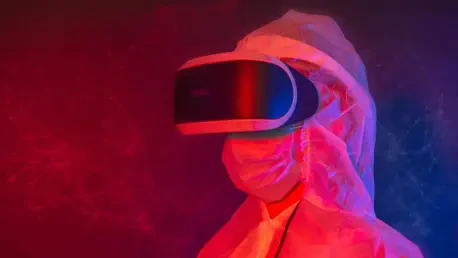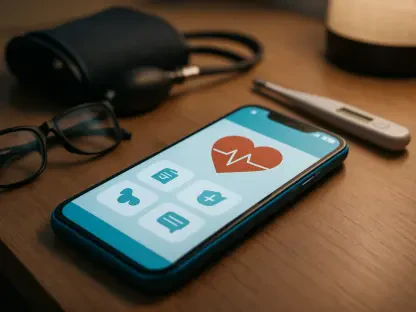The healthcare sector is witnessing an unprecedented transformation, driven by the remarkable integration of Augmented Reality (AR) and Virtual Reality (VR) technologies into medical equipment markets. These immersive tools have transcended the realm of science fiction to become vital components in how healthcare is delivered, from training the next generation of doctors to enhancing patient care with cutting-edge solutions. Valued at USD 23.27 billion in 2024, the AR VR Healthcare Equipment Market is projected to skyrocket to USD 104.67 billion by 2032, achieving a staggering Compound Annual Growth Rate (CAGR) of 20.68%. This explosive growth underscores the profound impact these technologies are having on the industry, offering unparalleled opportunities to improve precision in surgeries, elevate patient outcomes, and redefine global healthcare standards. Picture a world where a surgeon hones their skills in a completely risk-free virtual environment, or a patient finds relief from chronic pain through immersive distraction methods. Such scenarios are no longer dreams but tangible realities shaping the future of medicine. This article delves into the myriad ways AR and VR are revolutionizing healthcare equipment markets, exploring the economic potential, technological advancements, diverse applications, and regional dynamics that fuel this transformative wave. By examining the competitive landscape and future opportunities, a comprehensive understanding emerges of how these innovations are not just tools but catalysts for a smarter, more connected healthcare ecosystem.
Economic Surge and Market Expansion
The AR VR Healthcare Equipment Market is experiencing a remarkable surge, reflecting a robust appetite for innovative solutions in the medical field. Having grown from a valuation of USD 19.29 billion in 2023 to USD 23.27 billion in 2024, the market is on track to reach an impressive USD 104.67 billion by 2032, driven by a consistent CAGR of 20.68%. This rapid expansion is fueled by escalating investments from hospitals, clinics, and educational institutions that recognize the transformative potential of immersive technologies. The economic implications are vast, as these tools promise to reduce costs associated with traditional training methods and improve the efficiency of medical procedures. Beyond financial metrics, the market’s growth signals a shift in how healthcare stakeholders prioritize technology as a core component of operational strategy, paving the way for widespread adoption across various sectors of the industry.
This economic momentum is not merely a reflection of technological novelty but a response to genuine demand for enhanced healthcare delivery. Governments and private entities are funneling resources into AR and VR solutions, motivated by their ability to address critical challenges such as skill shortages and patient engagement. As funding continues to pour in, small and medium-sized enterprises are joining the fray alongside industry giants, creating a vibrant ecosystem of innovation. The ripple effects of this economic boom extend to job creation in tech development and clinical support roles, further embedding AR and VR into the fabric of healthcare economics. This dynamic growth trajectory highlights the market’s role as a cornerstone of modern medical progress, with far-reaching impacts on global health systems.
Cutting-Edge Technological Innovations
At the forefront of this healthcare revolution are groundbreaking advancements in AR, VR, and Mixed Reality (MR) technologies, which are redefining the capabilities of medical equipment. High-resolution head-mounted displays (HMDs) provide surgeons with real-time overlays during complex operations, ensuring precision that was previously unattainable. Ergonomic wearable devices are enhancing mobility and comfort for both practitioners and patients, while VR platforms create simulated environments for risk-free medical training. These innovations are often integrated with Artificial Intelligence (AI) and cloud computing, enabling data-driven insights and seamless connectivity. Such technological strides are not just improving existing processes but are opening doors to entirely new methods of diagnosis and treatment.
Beyond hardware, software developments are equally pivotal in pushing the boundaries of what AR and VR can achieve in healthcare settings. Sophisticated algorithms now power immersive rehabilitation programs that adapt to individual patient needs, offering personalized recovery paths. Virtual simulations for medical education are becoming increasingly realistic, allowing trainees to practice intricate procedures without ethical or safety concerns. The synergy between these technologies and other digital tools like the Internet of Things (IoT) facilitates remote monitoring and predictive diagnostics, ensuring proactive rather than reactive care. As these advancements continue to evolve, they are setting new standards for accuracy and efficiency, fundamentally altering the landscape of medical equipment markets.
Wide-Ranging Applications in Medicine
The versatility of AR and VR technologies is evident in their expansive applications across the healthcare spectrum, addressing diverse needs with tailored solutions. In surgical settings, AR systems overlay critical data directly into a surgeon’s field of view, enhancing decision-making during high-stakes procedures. VR, on the other hand, offers distraction-based therapies for pain management, reducing reliance on pharmaceuticals by immersing patients in calming virtual environments. These applications extend to diagnostics, where immersive visualizations aid in identifying conditions with greater accuracy, ultimately leading to better treatment plans. The ability of these technologies to adapt to various medical challenges underscores their growing indispensability.
Equally transformative are the roles of AR and VR in rehabilitation and mental health care, where they provide innovative approaches to recovery and therapy. Gamified VR programs engage patients in physical rehabilitation, turning repetitive exercises into interactive experiences that boost motivation and adherence. In mental health, immersive environments simulate scenarios to help individuals confront and manage conditions such as anxiety or post-traumatic stress disorder in a controlled, safe space. Patient education also benefits, as complex medical information is conveyed through intuitive virtual models, empowering individuals to take charge of their health. This broad applicability across clinical and therapeutic domains illustrates how AR and VR are not just tools but integral components of a holistic healthcare strategy.
Extensive Adoption Among End Users
The adoption of AR and VR technologies spans a wide range of end users, highlighting their adaptability to different healthcare contexts. Hospitals and surgical centers are at the forefront, utilizing these tools to refine surgical techniques and improve patient outcomes through enhanced precision. Rehabilitation clinics employ VR to create engaging therapy sessions that accelerate recovery, while medical training institutes integrate immersive simulations into curricula to prepare students for real-world challenges. This widespread uptake across clinical and educational settings demonstrates the universal appeal and utility of these technologies in addressing varied needs.
Beyond institutional use, telehealth providers are increasingly incorporating AR and VR to expand access to care, especially in remote or underserved areas. Virtual consultations enhanced by immersive tools allow for detailed assessments without the need for physical presence, bridging geographical gaps. Even patients and consumers are directly engaging with these technologies through wearable devices and apps designed for self-management of conditions like chronic pain or stress. This direct interaction empowers individuals to play an active role in their health, shifting the paradigm toward patient-centric care. The broad spectrum of end users adopting AR and VR solutions reflects a fundamental change in how healthcare is accessed and delivered, making these technologies indispensable across the board.
Global Trends and Regional Variations
Geographically, the integration of AR and VR in healthcare equipment markets reveals distinct patterns of growth and adoption influenced by regional strengths and challenges. North America stands as the leader, bolstered by advanced healthcare infrastructure, significant research and development capabilities, and the presence of key industry players driving innovation. Europe closely follows, supported by strong governmental initiatives for healthcare digitization and substantial funding for simulation-based training programs. These regions benefit from established ecosystems that facilitate rapid deployment and scaling of immersive technologies in medical settings.
Meanwhile, Asia-Pacific emerges as the fastest-growing region, propelled by expanding healthcare systems, rising telemedicine adoption, and increasing investments in technology. This growth is particularly notable in countries with burgeoning populations and a pressing need for scalable medical solutions. In contrast, South America and the Middle East & Africa are progressing more gradually, constrained by limited resources and infrastructure but showing potential as awareness and funding increase. These regional disparities highlight the importance of tailored strategies to address local barriers and leverage unique opportunities. Understanding these global trends is crucial for stakeholders aiming to navigate the complex dynamics of the AR VR healthcare market and ensure equitable access to transformative technologies worldwide.
Competitive Forces and Industry Pioneers
The AR VR Healthcare Equipment Market is characterized by intense competition, with major technology giants and specialized firms vying for dominance through relentless innovation. Companies like Microsoft, Meta Platforms, Google, and Sony are leading the charge, investing heavily in research and development to push the boundaries of immersive technology. Their efforts are complemented by niche players such as EON Reality and XRHealth, which focus on tailored solutions for specific medical needs. Strategic partnerships with healthcare institutions are a common tactic, ensuring that products are clinically relevant and meet real-world demands, thus enhancing market penetration.
This competitive landscape is further enriched by a focus on integrating complementary technologies like AI and cloud computing into AR and VR platforms. Such integrations enable advanced functionalities, from predictive analytics in patient care to scalable training modules for medical professionals. Industry leaders are also prioritizing the development of user-friendly, cost-effective solutions to broaden accessibility, particularly in emerging markets. As competition heats up, the emphasis on clinical validation and regulatory compliance becomes paramount, ensuring that innovations not only dazzle with potential but also deliver proven benefits. This vibrant rivalry fosters a culture of continuous improvement, positioning the market for sustained growth and groundbreaking advancements in healthcare delivery.
Horizons of Opportunity and Future Directions
Looking to the future, the potential for AR and VR in healthcare equipment markets appears boundless, with numerous opportunities on the horizon to further transform the industry. Telemedicine stands out as a key area, where immersive technologies can enhance remote consultations with detailed visualizations, making virtual care as effective as in-person visits. Surgical training simulations are another promising domain, offering safe, repeatable environments for honing skills that directly translate to better patient outcomes. Additionally, chronic disease management can benefit from personalized VR programs that support long-term adherence to treatment plans, addressing a critical public health need.
Emerging trends also point to the convergence of AR and VR with other cutting-edge technologies like AI and the Internet of Things (IoT), which promise to revolutionize personalized medicine and predictive diagnostics. As hardware becomes more affordable and software more intuitive, adoption is expected to surge, even in resource-constrained regions, democratizing access to advanced care. Regulatory frameworks will play a critical role in this expansion, as ensuring safety and efficacy remains a priority for widespread trust and implementation. Stakeholders must collaborate to navigate these challenges, focusing on innovation, affordability, and strategic partnerships to fully realize the potential of AR and VR. This forward-looking perspective signals a future where healthcare is not only more connected but profoundly patient-centric, driven by immersive technologies as foundational elements.









